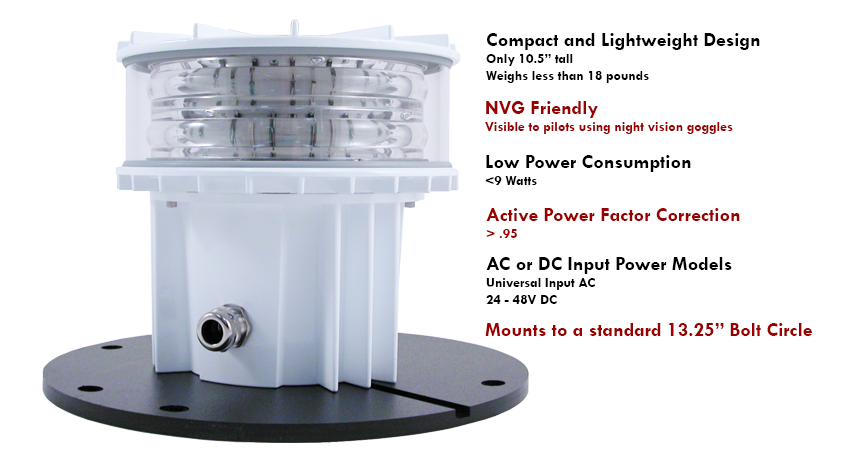We MANUFACTURE LED Obstruction Lights
Farlight's innovative LED obstruction lights and beacons help mark tall structures including towers, antennas, buildings, bridges and cranes as required by the FAA and ICAO.
Farlight manufactures obstruction lights that meet or exceed FAA and ICAO standards. Our energy-efficient LED obstruction lights combine the latest advances in lighting technology to ensure years of reliable, maintenance-free operation in the world's most demanding environments.
L-864 Medium Intensity RED Obstruction Light
The NV-L864LED is the smallest, lightest, and most efficient medium-intensity flashing red obstruction beacon on the market.
L-810 Low Intensity RED Obstruction Light
The L810LED is a highly efficient and reliable replacement for incandescent L-810 obstruction lights.
Several of our obstruction lights are compatible with Night Vision Goggles (NVGs) and Night Vision Imaging Systems (NVIS), making them the first true LED replacements for incandescent obstruction beacons.
NVG Friendly L-864 Obstruction Light
Farlight developed the first NVG Friendly LED L-864 Beacon on the market. The NV-L864LED is a compact and efficient obstruction lighting solution.
Farlight also offers obstruction lighting accessories including alarmed controllers, flashers, and FAA photocells.
If you're not sure which obstruction light is needed for your application, or if you have questions about the proper placement of obstruction lighting, please review the FAA's Advisory Circular on Obstruction Light Regulations. International customers should review the ICAO Annex 14, which contains standards used in Europe and many other countries.
General Guidelines for Obstruction Lighting
All temporary or permanent structures that exceed an overall height of 200 feet (61m) above ground level (AGL) should normally be marked and/or lighted.
Normally outside commercial lighting is not considered sufficient reason to omit recommended marking and/or lighting.
Specific recommendations on the use of obstruction lighting can vary depending on terrain features, weather patterns, air traffic patterns, and geographic location.
OBSTRUCTION LIGHTING GENERALLY FALLS INTO THREE CATEGORIES:
Aviation Red Obstruction Lights
Red obstruction lights are used to increase conspicuity during nighttime. Daytime and twilight marking (paint) is required. The red obstruction lighting system is composed of flashing omnidirectional beacons (L-864) and/or steady burning (L-810) lights. When one or more levels is comprised of flashing beacon lighting, the lights should flash simultaneously.
Medium Intensity Flashing White Obstruction Lights
Medium intensity flashing white obstruction lights may be used during daytime and twilight with automatically selected reduced intensity for nighttime operation.
When this system is used on structures 500 feet (153m) AGL or less in height, other methods of marking and lighting the structure may be omitted.
These systems are not normally recommended on structures 200 feet (61m) AGL or less as the flashing white lights at nighttime may annoy local communities. When a structure is located in an urban area where there are numerous other white lights (e.g., streetlights, etc.) red obstruction lights with painting or a medium intensity dual system is recommended.
Medium Intensity Dual Red / White Obstruction Lights
Dual systems consist of Red Medium Intensity Lights for nighttime and White Medium Intensity flashing lights for daytime and twilight.
The primary advantage of a dual lighting system on structures 500 feet (153m) or less, is that painting of the tower is not required.







